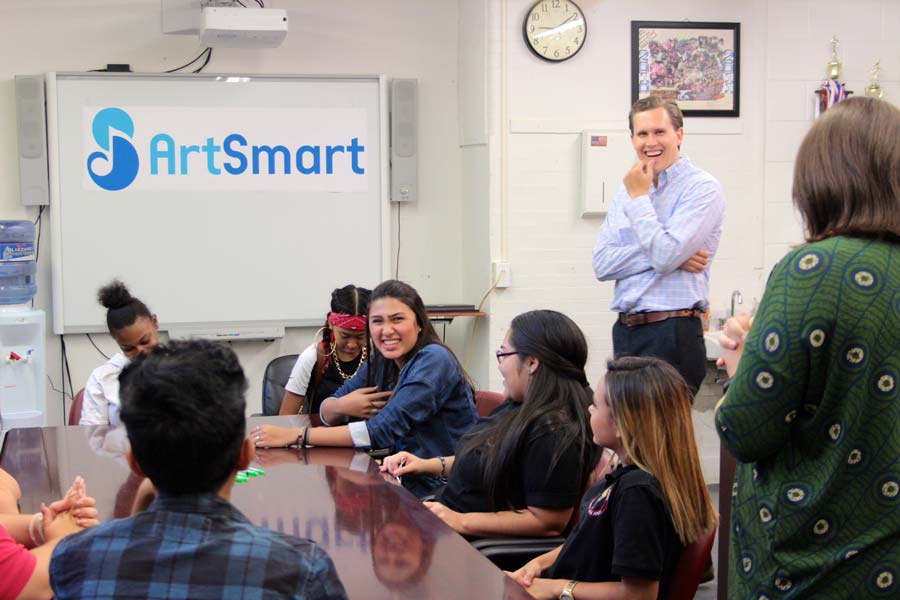
Recent data from the National Endowment for the Arts (NEA) and U.S. Bureau of Economic Analysis shows that the Arts contributed a whopping $704.2 Billion to the US economy in 2013 and a 32.5% growth in GDP from 1998 and 2013. Additionally, over that 15-year period, consumer spending on the performing arts grew 10% annually. These trends demonstrate the Arts are an important commodity for U.S. consumers. While Americans place a value on the arts, funding for the arts in schools continues to disappear at a dramatic rate. Now, more than ever, it’s important to advocate for the arts and fight to give students access. Here are 10 Reasons why giving students access to the arts matters:
The Arts make important economic contributions
As the data from the NEA shows, the Arts make important contributions to the U.S. economy and provide jobs for millions of Americans. If the arts and culture in the U.S. were a state, its $704.2 billion would be larger than the Gross State Product for 45 of 50 states. Removing arts education from students robs them of the opportunity to learn about career paths for the future and significant ways to feed the economy.
Teachers benefit from arts education
What is good for students is often good for educators. While most studies demonstrate the positive influence that arts education has on students, the “Learning In and Through the Arts” study found that teachers in high-arts schools were more open, flexible, knowledgeable, and engaged in their own ongoing learning compared to teachers in low-arts schools. Further, art teachers must learn to balance teaching across disciplines, which ultimately gives them the same benefits the students receive from taking arts classes.
Art increases critical thinking skills
In a randomized controlled trial involving 3,811 students who were assigned by lottery to participate in a school-sponsored visit to an Art Museum in Arkansas, students who participated in the School Visit Program demonstrated significantly stronger critical thinking skills when analyzing a new painting after the trip. Results were even stronger for students who had underprivileged backgrounds.
Exposure to art affects values and makes kids more empathetic
The same study also demonstrated that exposure to art made kids more empathetic by gaining awareness of different people, places, and ideas. Working in conjunction with critical thinking skills, this encourages kids to be more careful and thorough in how they observe the world and relate to other people.
Art is an inclusive universal language
The arts are the first official language of young children everywhere. Babies coo and smile to the sound of a parental lullaby; children scribble as a part of development. Most sought after toys feature bright colors and make a variety of sounds. Access to the arts in schools creates this same type of inclusive environment where all students, regardless of background and skill can participate and engage.
The arts improve social cohesion
Students from lower income families often get little exposure to the arts if they are not provided at school. A 2005 report from the Rand Corporation argues that arts education does far more than provide a “creative outlet,” but rather helps all students connect to a larger world thereby improving community cohesion. By providing access to the arts, this levels the playing field so that all students regardless of background have enrichment experiences.
Students learn how to collaborate through art and apply skills to other areas
Data suggests skills students gain through participating in operas can be applied more broadly. Operas force students to collaborate often and effectively especially pertaining to understanding the multiple layers of meaning. This in turn, as a researcher for the Harvard Graduate School of Education found through observation, leads to higher quality of work and deeper comprehension of complex subject material.
Art teaches unique habits not taught by other subjects
A 2007 study by Winner and Hetland revealed a spectrum of mental habits that students learn in the art classroom that are not typically acquired by other parts of school curricula. These include visual-spatial abilities, reflection, self-criticism, and the willingness to experiment and learn from their mistakes. The kinds of thinking are intrinsically important, but not the same type of skills a student might learn from math or science.
Art is an important complement to test preparation
The majority of public schools emphasize test preparation and classes are often lecture style. The arts are a much-needed reprieve for students that foster creativity and help sustain engagement in other subjects. Other countries like Hong Kong, Japan, Canada, and Finland, who all consistently outperform the U.S. in math and reading standardized tests, all require extensive education in the arts.
The arts make students smarter
In 2008, the Dana Foundation released a series of studies lead by neuroscientists that found a tight correlation between exposure to the arts and improved skills in cognition, attention to learning, and memory. This is because an interest in performing art leads to a high state of motivation that produces the sustained attention necessary to improve cognitive performance.
Article DETAILS:
By Liz Letak | Published on 10/07/2017

